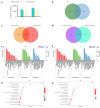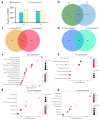Physiological and Multi-Omics Analysis in Leaves of Solanum americanum in Response to Cd Toxicity
- PMID: 40733368
- PMCID: PMC12299026
- DOI: 10.3390/plants14142131
Physiological and Multi-Omics Analysis in Leaves of Solanum americanum in Response to Cd Toxicity
Abstract
Phytoremediation is a green economic method to address soil cadmium (Cd) pollution, and Solanum americanum is considered a potential phytoremediation candidate. However, the underlying Cd response mechanisms of S. americanum remain unclear. In the current study, a hydroponic experiment with 160 μmol/L Cd stress was conducted, physiological and molecular indices were measured to explore the response of S. americanum leaves to Cd stress at different time points (0, 3, and 7 days). Our findings revealed that Cd stress inhibited plant growth. Moreover, Cd stress significantly increased Cd accumulation, as well as Chla content, Chla/b, activities of SOD and POD, and elevated MDA content in the leaves. Furthermore, transcriptomics, proteomics, and metabolomics analyses revealed 17,413 differentially expressed genes (DEGs), 1421 differentially expressed proteins (DEPs), and 229 differentially expressed metabolites (DEMs). Meanwhile, integrative analyses of multi-omics data revealed key proteins involved in response to Cd stress, including POD, PAL, F5H, COMT, and CAD for phenylpropanoid biosynthesis, as well as GAPA, FBP, and FBA for photosynthesis pathways. Additionally, conjoint analyses highlighted that upregulated phenylpropanoid metabolism and photosynthesis alleviated Cd toxicity, playing vital roles in enhancing Cd tolerance in leaves. A conceptual molecular regulatory network of leaves in the response to Cd toxicity was proposed. This comprehensive study will provide detailed molecular-scale insights into the Cd response mechanisms in S. americanum.
Keywords: Cd stress; Solanum americanum; leaf; metabolomics; proteomic; transcriptomic.
Conflict of interest statement
The authors declare no conflicts of interest.
Figures










Similar articles
-
Integrative Transcriptome and Metabolome Analysis Identifies Potential Pathways Associated with Cadmium Tolerance in Two Maize Inbred Lines.Plants (Basel). 2025 Jun 16;14(12):1853. doi: 10.3390/plants14121853. Plants (Basel). 2025. PMID: 40573841 Free PMC article.
-
Physiological and metabolic responses of Sophora tonkinensis to cadmium stress.Physiol Mol Biol Plants. 2024 Nov;30(11):1889-1907. doi: 10.1007/s12298-024-01522-w. Epub 2024 Oct 28. Physiol Mol Biol Plants. 2024. PMID: 39687702
-
Integrated analysis of miRNA-mRNA regulatory networks of potato (Solanum tuberosum L.) in response to cadmium stress.Ecotoxicol Environ Saf. 2021 Nov;224:112682. doi: 10.1016/j.ecoenv.2021.112682. Epub 2021 Aug 19. Ecotoxicol Environ Saf. 2021. PMID: 34419646
-
Interventions for the management of abdominal pain in Crohn's disease and inflammatory bowel disease.Cochrane Database Syst Rev. 2021 Nov 29;11(11):CD013531. doi: 10.1002/14651858.CD013531.pub2. Cochrane Database Syst Rev. 2021. PMID: 34844288 Free PMC article.
-
Systemic pharmacological treatments for chronic plaque psoriasis: a network meta-analysis.Cochrane Database Syst Rev. 2021 Apr 19;4(4):CD011535. doi: 10.1002/14651858.CD011535.pub4. Cochrane Database Syst Rev. 2021. Update in: Cochrane Database Syst Rev. 2022 May 23;5:CD011535. doi: 10.1002/14651858.CD011535.pub5. PMID: 33871055 Free PMC article. Updated.
References
-
- Phlsson A.M.B. Toxicity of heavy metals (Zn, Cu, Cd, Pb) to vascular plants. Water Air Soil Poll. 1989;47:287–319. doi: 10.1007/BF00279329. - DOI
-
- Gallego S.M., Pena L.B., Barcia R.A., Azpilicueta C.E., Iannone M.F., Rosales E.P., Zawoznik M.S., Groppa M.D., Benavides M.P. Unravelling cadmium toxicity and tolerance in plants: Insight into regulatory mechanisms. Environ. Exp. Bot. 2012;83:33–46. doi: 10.1016/j.envexpbot.2012.04.006. - DOI
Grants and funding
LinkOut - more resources
Full Text Sources
Miscellaneous

